
New, centrally acting dopaminergic agents with an improved oral bioavailability [2004]
.pdf
Thiophene analogues of naphthoxazines and 2-aminotetralins
Table 4.1. Binding affinities of some dopamine receptor compounds.
|
|
|
Ki (nM) |
|
|
Compound |
Reference |
D2L |
D3 |
5-HT1A |
|
|
|
Agonist |
[3H]spiperone |
[3H]8-OH-DPAT |
|
N-0437 (31) |
223 |
0.06a |
4.0 |
– |
|
7-OH-DPAT (10) |
247 |
34a |
1.4 |
– |
|
pramipexole (19) |
155 |
2.07d |
0.49d |
– |
|
5-OH-DPAT (9) |
248 |
6a |
0.66 |
– |
|
8-OH-DPAT (74) |
249 |
3200b |
250 |
0.9 |
|
R-DPAT (R-73) |
241 |
32c |
33 |
12 |
|
S-DPAT (S-73) |
241 |
5.5c |
35 |
38 |
|
34 |
239 |
27b |
28 |
80 |
|
35 |
239 |
40b |
20 |
– |
|
38 |
239 |
>4780b |
3003 |
– |
|
39 |
239 |
631b |
237 |
– |
|
27a |
206 |
2.8e |
|
|
|
75 |
206 |
80e |
|
|
|
76 |
206 |
110e |
|
|
|
Footnotes: a |
[3H]N-0437; b |
[3H]N-n-propylnorapomorphine; c [3H]quinpirole; d [3H]spiperone, |
|||
high affinity binding; e IC50 (nM) in rat striatal membrane homogenates using [3H]DP-5,6-ADTN.
To determine whether a thiophene moiety can act as a bioisostere for a phenol moiety compounds 34, 35, 38, 39 were tested for their effects on dopamine release using the microdialysis technique in freely moving rats. The effects of compounds 34 and 35 were compared with the effects of the prototypic dopamine receptor agonist 5-OH-DPAT. On the basis of structural similarities it was thought that compound 34 could be related to 8-OH-DPAT and compound 35 to 5-OH-DPAT. However, compound 34 also showed affinities for the dopamine D2 and D3 receptors and therefore this compound was also studied for its effects on dopamine release. Since all hydroxylated 2-aminotetralins possess a free phenolic hydroxyl group they are prone to conjugation reactions.161 However, there is a difference to what extent the compound is glucuronidated depending on the position of the hydroxyl moiety. In this study the compounds are compared with 5-OH-DPAT which is the least glucuronidated of the isomeric dopaminergic monophenolic 2-aminotetralins.161 The relative oral bioavailabilities of compounds 34 and 35 were determined. No such estimation was made for compounds 38 and 39 since these compounds displayed limited affinity for the dopamine D2 and D3 receptors. In addition, compounds 34 and 35 tested for their locomotor activity and dopamine and serotonin receptor behavioural characteristics in reserpinised rats.
71

Chapter 4
4.2Materials and methods
4.2.1Animals
Male Wistar rats (from CDL, Groningen, The Netherlands) weighing 280-320 g were used for microdialysis experiments and rats weighing 180-220 g for the locomotor activity and behavioural characteristics experiments. The rats were housed in Plexiglas cages, eight animals in each cage, with free access to water and food. The cages were placed in a room with controlled environmental conditions (21 °C; humidity 60-65%; lights on at 8 a.m. and off at 8 p.m.). The animals were housed at least one week after arrival prior to surgery and use in the experiments. Animal procedures were conducted in accordance with guidelines published in the NIH Guide for the Care and Use of Laboratory Animals and all protocols were approved by the Groningen University Institutional Animal Care and Use Committee.
4.2.2Drug treatment
The drugs were dissolved in saline and stored in a concentration of 100 µmol/ml for subcutaneous (s.c.) and 50 µmol/ml for per oral (p.o.) administration and diluted, if necessary, with saline before administration. A volume of 1 ml/kg was administered for s.c. administration and 2 ml/kg for p.o. administration. The drugs that were used were 6-(N,N-di-n- propylamino)tetrahydrobenzo[b]thiophene (34), 5-(N,N-di-n-propylamino)tetrahydro- benzo[b]thiophene (35), 5-hydroxy-2-(N,N-di-n-propylamino)tetralin (5-OH-DPAT, 9), trans- 2,3,4a,5,6,10b-hexahydro-4H-thianaphth[4,5e][1,4]oxazine (38) and trans-N-n-propyl- 2,3,4a,5,6,10b-hexahydro-4H-thianaphth[4,5e][1,4]oxazine (39). All five drugs were synthesised at the Department of Medicinal Chemistry in Groningen.
4.2.3Surgery and brain microdialysis
On-line brain microdialysis in freely moving animals has previously been described.188 In brief, the rats were anaesthetised with midazolam (5 mg/kg s.c.), atropine nitrate (0.1 mg/kg s.c.), ketamine (50 mg/kg i.p.) and xylazine (8 mg/kg i.p.); 10% lidocaine was locally applied. The rats were then mounted into a stereotaxic frame (Kopf). The incisor bar was placed in position so that the skull was held horizontal. The skull was exposed and burr holes were drilled. A Y-shaped dialysis probe was used for the experiments, with an exposed tip length of 3 mm. The dialysis tube (ID: 0.22 mm; OD: 0.31 mm) was prepared from polyacrylonitrile/sodium methallyl sulfonate copolymer (AN 69, Hospal, Bologna, Italy). The microdialysis membrane was implanted in the striatum. The dura was removed with a sharp needle. Two anchor screws were positioned in different bone plates nearby. The following coordinates were used according to the atlas of Paxinos and Watson:250 AP + 1.0, LM ± 3.0
72

Thiophene analogues of naphthoxazines and 2-aminotetralins
relative to bregma, and VD − 6.0 below dura. Before insertion into the brain the dialysis probe was perfused successively with ultra pure water, methanol, ultra pure water and Ringer solution (1.2 mM Ca2+). The dialysis probe was positioned in the burr hole under stereotaxic guidance. The probe was cemented in this position with dental cement. After the surgery, the rats received buprenorphine (0.1 mg/kg i.m.), an analgesic agent. The rats were housed solitary.
The experiments were performed in conscious rats 17-48 h after implantation of the cannula.
The striatum was perfused with a Ringer solution (147 mmol/l NaCl, 4 mmol/l KCl, 1.2 mmol/l CaCl2, 1.1 mmol/l MgCl2) at 2 μl/min (CMA/102 microdialysis pump, Sweden).
Dopamine was quantitated by high-performance liquid chromatography (HPLC) with electrochemical detection with a detection limit of approximately 5 fmol/sample. An HPLC pump (LKB, Pharmacia) was used in conjunction with an electrochemical detector (Antec, Leiden) working at 625 mV versus an Ag/AgCl reference electrode. The analytical column was a Supelco Supelcosil LC-18 Column (3 µm particle size). The mobile phase consisted of a mixture of 4.1 g/l sodium acetate (Merck), 85 mg/l octane sulphonic acid (Aldrich), 50 mg/l EDTA (Merck), 1 mM tetramethylammonium chloride (ACROS), 8.5 % methanol (Labscan) and ultra pure water (pH=4.1 with glacial acetic acid).
After the experiments the rats were sacrificed and the brains were removed. After removal the brains were kept in 4% paraformaldehyde solution until they were sectioned to control the location of the dialysis probes.
4.2.4 Locomotor activity as monitored in automated cages and behavioural characteristics
Reserpine (10 mg/kg s.c.) was administered 18 h prior to the start of the experiments. On the day of the experiments the animals were placed alone in Plexiglas boxes during a period of 15 min for habituation. Subsequently, the test compounds were administered subcutaneously. The locomotor activity was registered during a period of 120 min using AUTOMEX II activity monitors (Columbus Instruments, Columbus, OH, USA).
During a period of 60 min the behaviour of the rats was scored manually every 5 minutes. The behaviour scored was repeated sniffing, repeated licking and rearing as dopamine receptor stereotyped behaviour and flat body posture and lower lip retraction as indications of the 5-hydroxytryptamine (5-HT, serotonin) behavioural syndrome. The behaviour was scored when it lasted for more than half the observation period. The effects of the compounds were compared to a saline-treated control group.
4.2.5Statistics
Data of the microdialysis experiments were converted into percentage of the basal levels. The basal levels were determined from four consecutive samples (less than 20% variation), and set at 100%. During a period of 165 min after administration of the test compound the dopamine
73

Chapter 4
release was measured. Microdialysis data were analysed using one-way Analysis of Variance (ANOVA) for repeated measurements, followed by Dunnett’s Method post-hoc test. The relative oral bioavailabilities were determined by comparing the Area Under the Curves (AUCs) after p.o. and s.c. administration. When the AUCs were not significantly different, the relative oral bioavailability, as expressed in percent, was determined by dividing the s.c. dose by the p.o. dose and multiplying by 100. Statistical analysis of the AUCs was performed by a t-test. The data of the locomotor activity experiments were analysed using Two Way Repeated Measures ANOVA on One Factor Balanced Design, followed by Student-Newman-Keuls Method post-hoc test. In all cases a significance level of 0.05 was applied.
4.3Results
4.3.1In vivo microdialysis
The basal dialysate concentrations in the striatum for the experiments were 11.1 ± 0.96 fmol/min (n = 62).
The results of the microdialysis experiments of the compounds 34, 35, 5-OH-DPAT, 38 and
39 are shown in Figure 4.1-4.4. S.c. administration of all compounds, except compound 38, induced a dose-dependent and significant decrease in the release of dopamine in the striatum. Furthermore, compounds 34, 35 and 5-OH-DPAT also induced a significant decrease in the release of dopamine in the striatum after p.o. administration. Effects of compounds 38 and 39 were not studied upon p.o. administration.
The significant decrease in dopamine release induced by s.c. administration of a dose of 0.1 µmol/kg of compound 34 lasted from t = 30 min to t = 45 min with a maximum decrease of 20 % of control values. For a dose of 1 µmol/kg this was from t = 30 min to t = 105 min with a maximum decrease of 60 % of control values and for a dose of 10 µmol/kg the significant decrease lasted from t = 30 min to t = 165 min with a maximum of 75 % of control values (Figure 4.1A). Figure 4.1B shows that the significant decrease after p.o. administration of compound 34 in a dose of 1 µmol/kg lasted from t = 15 min to t = 60 min with a maximum decrease of 25 % and in a dose of 10 µmol/kg from t = 30 min to t = 135 min with a maximum decrease of 40 % of control values.
74
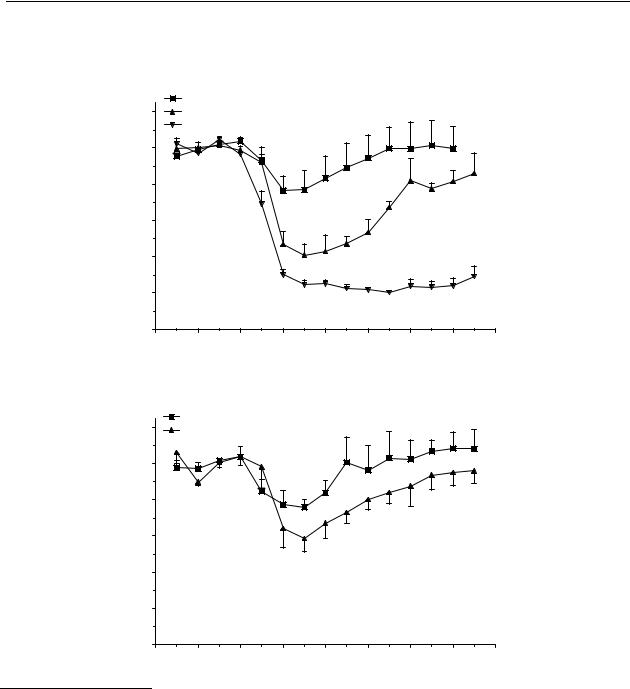
Thiophene analogues of naphthoxazines and 2-aminotetralins
A
Compound 34
|
120 |
0.1 µmol/kg s.c. |
|
|
|
|
|
|
|
|
|
|
|
1 µmol/kg s.c. |
|
|
|
|
|
|
|
|
|
||
|
|
10 µmol/kg s.c. |
|
|
|
|
|
|
|
|
|
|
values) |
100 |
|
|
|
|
|
|
|
|
|
|
|
|
|
|
* |
* |
|
|
|
|
|
|
|
|
|
|
|
|
|
|
|
|
|
|
|
||
80 |
|
|
|
|
|
|
|
|
|
|
|
|
basal |
|
|
|
|
|
|
|
* |
|
|
|
|
|
|
|
|
|
|
|
|
|
|
|
||
|
|
|
|
|
|
|
* |
|
|
|
|
|
of |
60 |
|
|
|
|
|
|
|
|
|
|
|
|
|
* |
|
* |
|
|
|
|
|
|
||
(% |
|
|
|
* |
|
|
|
|
|
|||
|
|
|
|
* |
|
|
|
|
|
|||
|
|
|
|
|
|
|
|
|
|
|
||
release |
|
|
|
|
|
|
|
|
|
|
|
|
40 |
|
|
* |
|
|
|
|
|
|
|
* |
|
|
|
|
* |
* |
|
|
* |
|
* |
|
||
|
|
|
|
* |
* |
* |
|
|||||
|
|
|
|
|
|
|||||||
DA |
20 |
|
|
|
|
|
|
* |
|
|
|
|
|
|
|
|
|
|
|
|
|
|
|
||
|
0 |
|
|
|
|
|
|
|
|
|
|
|
|
-60 |
-30 |
0 |
30 |
|
60 |
|
90 |
120 |
|
150 |
180 |
Time (min)
B
Compound 34
|
120 |
1 µmol/kg p.o. |
|
|
|
|
|
|
|
|
|
10 µmol/kg p.o. |
|
|
|
|
|
|
|
||
values) |
100 |
|
|
|
* |
|
|
|
|
|
|
|
|
* |
|
|
|
|
|
||
|
|
|
* |
|
|
|
|
|
||
80 |
|
|
|
|
|
|
* |
|
||
basal |
|
|
* |
|
|
|
|
|||
|
|
|
|
* |
|
|
||||
|
|
|
|
|
* |
* |
|
|
||
|
|
|
|
|
|
|
|
|||
|
|
|
|
|
|
|
|
|
|
|
of |
60 |
|
|
|
|
* |
|
|
|
|
|
|
|
|
|
|
|
|
|
||
(% |
|
|
|
* |
|
|
|
|
|
|
|
|
|
* |
|
|
|
|
|
||
|
|
|
* |
|
|
|
|
|
||
DA release |
|
|
|
|
|
|
|
|
||
|
|
|
|
|
|
|
|
|
||
40 |
|
|
|
|
|
|
|
|
|
|
20 |
|
|
|
|
|
|
|
|
|
|
|
0 |
|
|
|
|
|
|
|
|
|
|
-60 |
-30 |
0 |
30 |
60 |
90 |
|
120 |
150 |
180 |
Time (min)
Figure 4.1 Effect of s.c. (A) and p.o. (B) administration of 6-(N,N-di-n-propylamino)tetrahydro- benzo[b]thiophene (34) on striatal dopamine release in freely moving rats. Data are presented as mean ± S.E.M. (n = 4). * P<0.05 (Dunnett’s test).
Compound 35, upon s.c. administration, induced a significant decrease in dopamine release of maximally 35 %, 55 %, and 65 % after doses of 1, 10 and 30 µmol/kg, respectively (Figure 4.2A). The decrease induced by a dose of 1 µmol/kg lasted only 30 min, while the doses of 10 and 30 µmol/kg both induced decreases in dopamine release that lasted until 165 min after administration. The significant effect of administration of a dose of 10 µmol/kg p.o. and a dose
75
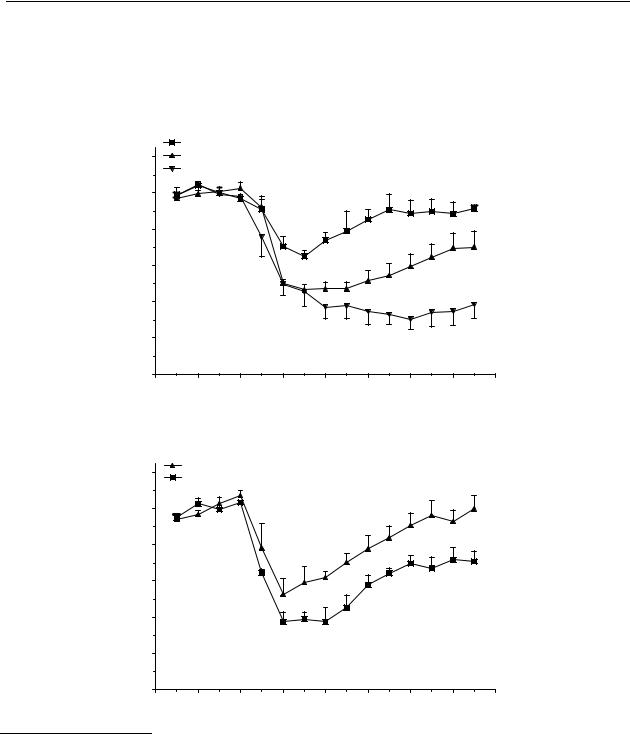
Chapter 4
of 30 µmol/kg p.o. of compound 35 lasted from t = 30 min to t = 90 min for both doses with a maximum decrease of 50 % and 60 % of control values, respectively (Figure 4.2B).
A
Compound 35
|
|
1 µmol/kg s.c. |
|
|
|
|
|
|
|
|
|
|
|
120 |
10 µmol/kg s.c. |
|
|
|
|
|
|
|
|
|
|
|
|
30 µmol/kg s.c. |
|
|
|
|
|
|
|
|
|
|
values) |
100 |
|
|
|
|
|
|
|
|
|
|
|
80 |
|
|
|
|
* |
|
|
|
|
* |
* |
|
basal |
|
|
* |
|
|
|
|
|
||||
|
|
|
|
|
|
* |
|
|||||
|
|
|
|
* |
|
|
|
* |
|
|
||
|
|
|
|
|
|
|
|
|
|
|||
|
|
|
|
|
|
|
* |
|
|
|
||
|
|
|
|
|
|
|
|
|
|
|
||
of |
60 |
|
|
* |
|
|
* |
|
|
|
|
|
|
|
|
|
|
|
|
|
|
||||
(% |
|
|
|
* |
* |
* |
* |
|
|
|
|
|
|
|
|
|
|
|
|
|
|
||||
release |
40 |
|
|
* |
* |
|
|
|
|
|
|
|
|
|
|
|
|
|
|
|
|
|
|
||
|
|
|
|
|
* |
* |
|
|
|
|
* |
|
DA |
|
|
|
|
|
* |
|
|
|
|||
20 |
|
|
|
|
|
* |
* |
* |
* |
|
||
|
|
|
|
|
|
|
|
|||||
|
0 |
|
|
|
|
|
|
|
|
|
|
|
|
-60 |
-30 |
0 |
30 |
|
60 |
90 |
|
120 |
|
150 |
180 |
Time (min)
B
Compound 35
|
120 |
10 µmol/kg p.o. |
|
|
|
|
|
|
|
|
|
30 µmol/kg p.o. |
|
|
|
|
|
|
|
||
|
|
|
|
|
|
|
|
|
||
values) |
100 |
|
|
|
|
|
|
|
|
|
|
|
|
|
|
|
* |
|
|
|
|
80 |
|
|
|
|
|
|
|
|
|
|
basal |
|
|
|
|
|
* |
|
|
|
|
|
|
|
* |
* |
* |
* |
|
|
|
|
of |
|
|
|
|
|
|
|
|
||
60 |
|
|
|
|
|
|
|
|
||
|
|
|
|
|
* |
|
|
|
||
(% |
|
|
|
|
|
|
|
|
||
|
|
|
|
|
|
|
|
|
||
|
|
|
|
|
* |
|
|
|
|
|
DA release |
|
|
|
* |
* |
|
|
|
|
|
40 |
|
|
|
|
|
|
|
|||
|
|
|
|
|
|
|
|
|
||
20 |
|
|
|
|
|
|
|
|
|
|
|
0 |
|
|
|
|
|
|
|
|
|
|
-60 |
-30 |
0 |
30 |
|
60 |
90 |
120 |
150 |
180 |
Time (min)
Figure 4.2 Effect of s.c. (A) and p.o. (B) administration of 5-(N,N-di-n-
propylamino)tetrahydrobenzo[b]-thiophene (35) on striatal dopamine release in freely moving rats. Data are presented as mean ± S.E.M. (n = 4). * P<0.05 (Dunnett’s test).
For comparison, administration of a s.c. dose of 0.1 µmol/kg and a p.o. dose of 10 µmol/kg of 5-OH-DPAT (9) induced very similar effects. Both treatments induced a significant decrease in dopamine release from 15 to 165 min with a maximum decrease in dopamine release of 70 %
76
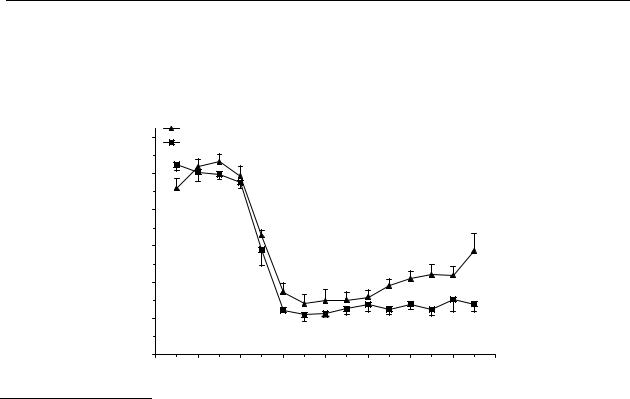
Thiophene analogues of naphthoxazines and 2-aminotetralins
and 75 % of control values for a s.c. dose of 0.1 µmol/kg and a p.o. dose of 10 µmol/kg, respectively (Figure 4.3).
|
|
|
|
|
|
5-OH-DPAT |
|
|
|
|
|
|
||
|
120 |
0.1 µmol/kg sc |
|
|
|
|
|
|
|
|
|
|
|
|
|
10 µmol/kg po |
|
|
|
|
|
|
|
|
|
|
|
||
|
|
|
|
|
|
|
|
|
|
|
|
|
||
values) |
100 |
|
|
|
|
|
|
|
|
|
|
|
|
|
80 |
|
|
|
|
|
|
|
|
|
|
|
|
|
|
of basal |
|
|
|
|
|
|
|
|
|
|
|
|
|
|
|
|
|
* |
|
|
|
|
|
|
|
|
|
* |
|
|
|
|
|
|
|
|
|
|
|
|
|
|
||
60 |
|
|
|
|
|
|
|
|
|
|
|
|
|
|
(% |
|
|
|
|
|
|
|
|
|
|
* |
|
|
|
|
|
|
|
|
|
|
|
|
|
* |
* |
|
||
DA release |
|
|
|
* |
|
|
|
|
|
* |
|
|
|
|
40 |
|
|
* * |
|
* |
|
* |
|
|
|
|
|||
|
|
|
|
* |
|
|
|
|
|
|||||
|
|
|
|
* |
|
|
|
|
|
|||||
|
|
|
|
|
|
|
|
|
|
|
|
|
||
20 |
|
|
|
* |
* |
* |
* |
* |
* |
* |
* |
* |
* |
|
|
|
|
|
|
|
|
|
|
|
|||||
|
|
|
|
|
|
|
|
|
|
|
|
|
|
|
|
0 |
|
|
|
|
|
|
|
|
|
|
|
|
|
|
-60 |
-30 |
0 |
|
30 |
|
60 |
|
90 |
|
120 |
|
150 |
180 |
Time (min)
Figure 4.3 Effect of s.c. and p.o. administration of 5-OH-DPAT on striatal dopamine release in freely moving rats. Data are presented as mean ± S.E.M. (n = 4). * P<0.05 (Dunnett’s test).
Figure 4.4 shows that trans-2,3,4a,5,6,10b-hexahydro-4H-thianaphth[4,5e][1,4]oxazine (38) had no significant effect on the release of dopamine in the striatum in a dose of 100 µmol/kg s.c.
Compound 39 in a s.c. dose of 1 µmol/kg had no effect on the release of dopamine, while s.c. administration of 10 µmol/kg induced a significant decrease in the release of dopamine in the striatum from t = 30 min to t = 60 min with a maximum decrease of 40 %. The significant effect of s.c. administration of 50 µmol/kg lasted from t = 15 min to t = 150 min with a maximum of 65 % (Figure 4.4).
77
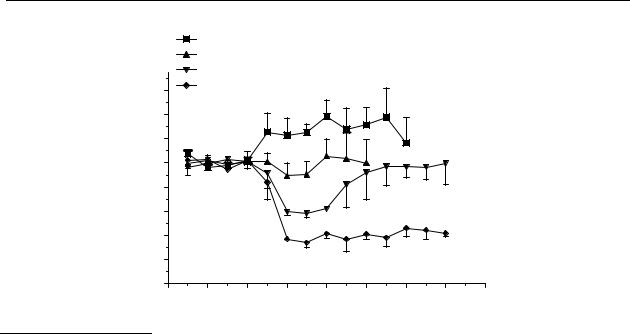
Chapter 4
|
|
Compound 38 100 mmol/kg s.c. |
|
|
|
|
|||||
|
|
Compound 39 |
1 mmol/kg s.c. |
|
|
|
|
||||
|
|
Compound 39 |
10 mmol/kg s.c. |
|
|
|
|
||||
values) |
160 |
Compound 39 |
50 mmol/kg s.c. |
|
|
|
|
||||
|
|
|
|
|
|
|
|
|
|
||
140 |
|
|
|
|
|
|
|
|
|
|
|
120 |
|
|
|
|
|
|
|
|
|
|
|
basal |
|
|
|
|
|
|
|
|
|
|
|
100 |
|
|
|
|
|
|
|
|
|
|
|
of |
80 |
|
|
|
|
|
|
|
|
|
|
(% |
|
|
|
|
|
|
|
|
|
|
|
60 |
|
|
* |
|
|
|
|
|
|
|
|
release |
|
|
|
* |
|
|
|
|
|
||
|
|
|
* |
* |
|
|
|
|
|
||
40 |
|
|
|
|
|
|
|
|
|||
|
|
|
|
* |
* |
* |
* |
* |
|
||
|
|
|
* |
|
|
||||||
DA |
20 |
|
|
* |
|
* |
* |
|
|
|
|
|
|
|
|
|
|
|
|||||
0 |
|
|
|
|
|
|
|
|
|
|
|
|
-30 |
0 |
30 |
|
60 |
90 |
120 |
|
150 |
180 |
|
|
-60 |
|
|
||||||||
Time (min)
Figure 4.4 Effect of s.c. administration of trans-2,3,4a,5,6,10b-hexahydro-4H-
thianaphth[4,5e][1,4]-oxazine (38) and trans-N-n-propyl-2,3,4a,5,6,10b-hexahydro-4H- thianaphth[4,5e][1,4]oxazine (39) on striatal dopamine release in freely moving rats. Data are presented as mean ± S.E.M. (n = 4). * P<0.05 (Dunnett’s test).
The relative oral bioavailabilities, as determined by comparing the AUC after s.c. and p.o. administration, of 6-(N,N-di-n-propylamino)tetrahydrobenzo[b]thiophene (34), 5-(N,N-di-n- propylamino)tetrahydrobenzo[b]thiophene (35) and 5-OH-DPAT (9) were calculated from Figures 4.1-4.3, and are shown in Table 4.2. For compounds 34 and 35 the relative oral bioavailabilities were ³ 10 %, while for the reference compound 5-OH-DPAT it was 1 %. In order to verify the fact that the decrease induced by a dose of 10 µmol/kg p.o. was not already induced by a lower dose, we have found that a dose of 1 µmol/kg p.o. of 5-OH-DPAT induced a decrease in the release of dopamine in the striatum of only 50-55 %. Furthermore, microdialysis experiments in our laboratory with the (–)-enantiomer of 5-OH-DPAT also showed that the relative oral bioavailability was about 1-3 % (Chapter 7).
78

Thiophene analogues of naphthoxazines and 2-aminotetralins
Table 4.2 AUCs |
of |
the |
microdialysis |
experiments |
of |
6-(N,N-di-n- |
|
propylamino)tetrahydrobenzo[b]thiophene (34), |
5-(N,N-di-n-propylamino)tetrahydrobenzo[b]thiophene |
||||||
(35) and 5-OH-DPAT (9) after s.c. and p.o. administration. |
|
|
|
||||
|
|
|
|
|
|
||
|
Subcutaneous |
|
Oral administration |
|
Relative oral |
||
|
administration |
|
|
|
bioavailability (%) |
||
Compound |
Dose |
AUC |
Dose |
AUC |
|
|
|
|
(µmol/kg) |
|
|
(µmol/kg) |
|
|
|
34 |
0.1 |
2650 ± 1000a |
1 |
2730 ± 390a |
|
10 |
|
|
1 |
6000 ± 500 |
10 |
3700 ± 950 |
|
10 |
|
|
10 |
12446 ± 335 |
|
|
|
|
|
35 |
1 |
3150 ± 400 |
10 |
4100 ± 750 |
|
10 |
|
|
10 |
6700 ± 800 |
10 |
4100 ± 750 |
|
100 |
|
|
10 |
6700 ± 800 |
30 |
7000 ± 450 |
|
30 |
|
|
30 |
9400 ± 960 |
30 |
7000 ± 450 |
|
100 |
|
5-OH-DPAT (9) |
0.1 |
9700 ± 500 |
10 |
11500 ± 300 |
|
1 |
|
Footnotes: a Experiment lasted 150 min. All other experiments lasted 165 min. All the AUCs of s.c. and p.o. doses of each compound were compared, but only the doses that were not significantly different were put in line in the table.
4.3.2Locomotor activity in reserpinised rats
Both compounds 34 and 35 induced a significant increase in locomotor activity in reserpinised rats (Figure 4.5). The basal level of locomotor activity of reserpinised rats is maximally 48.5 ± 18.8 counts per 15 min (n = 4) as measured upon s.c. administration of saline. When comparing their maximum effect on locomotor activity as measured by the number of counts over 15 min, compound 34, in a dose of 10 µmol/kg, induced an increase in locomotor activity to 600 counts/15 min, which returned to basal levels after 60 min. In a dose of 30 µmol/kg the maximum effect was 750 counts/15 min, which returned to basal levels after 90 min. The effects of compound 35 in the same doses were less pronounced than those for compound 34. In a dose of 10 µmol/kg compound 35 induced an increase in locomotor activity to maximally 300 counts/15 min and in a dose of 30 µmol/kg the maximum effect was 650 counts/15 min The latter returned to basal levels after 105 min.
79
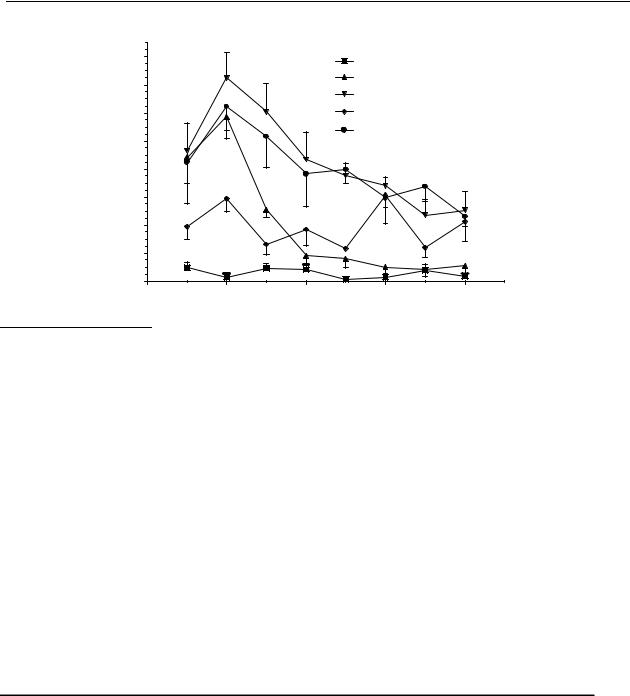
Chapter 4
|
800 |
* |
|
saline s.c. |
|
|
|
|
|
|
|||
min) |
|
|
|
|
||
700 |
|
* |
Compound 34 10 µmol/kg s.c. |
|||
|
Compound 34 30 µmol/kg s.c. |
|||||
(counts/15 |
|
|
|
|||
600 |
* |
|
Compound 35 10 mol/kg s.c. |
|||
|
* |
Compound 35 30 mol/kg s.c. |
||||
500 |
* |
|||||
|
|
|
||||
* |
|
|
|
|||
activity |
400 |
|
|
* |
|
|
* |
* |
* |
|
|||
|
|
|||||
|
|
* |
|
|||
300 |
|
|
* |
|||
Locomotor |
|
|
|
|||
|
* |
* |
|
|
||
|
* |
|
|
|||
200 |
* |
|
|
|||
|
* |
|
||||
|
|
|
|
|||
100 |
|
|
|
|
||
|
0 |
|
|
|
|
|
|
0 |
30 |
60 |
90 |
120 |
|
Time (min)
Figure 4.5 The effect of 6-(N,N-di-n-propylamino)tetrahydrobenzo[b]thiophene (34) and 5-(N,N- di-n-propylamino)tetrahydrobenzo[b]thiophene (35) on the locomotor activity of reserpinised rats. Data are presented as mean ± S.E.M. (n = 4). * P<0.05 (Student- Newman-Keuls test).
4.3.3Behaviour in reserpinised rats
Table 4.3 shows that s.c. administration of compound 34 induced both dopamine receptor stereotyped behaviour (sniffing, licking and rearing) and a 5-HT behavioural syndrome (flat body posture and lower lip retraction) in the reserpinised rats. Administration of compound 35 induced dopamine receptor but no serotonin receptor behaviour.
Table 4.3 Behaviour after s.c. administration of the tetrahydrobenzo[b]thiophenes 34 and 35
represented as the number of animals which showed the behaviour of the total number of animals used in the experiment.
Compound |
Dose |
Sniffing |
Licking |
Rearing |
Flat body |
Lower lip |
|
µmol/kg s.c. |
|
|
|
posture |
retraction |
34 |
10 |
4/4 |
0/4 |
0/4 |
2/4 |
2/4 |
34 |
30 |
4/4 |
2/4 |
3/4 |
4/4 |
4/4 |
35 |
10 |
4/4 |
4/4 |
0/4 |
0/4 |
0/4 |
35 |
30 |
4/4 |
4/4 |
4/4 |
0/4 |
0/4 |
80
